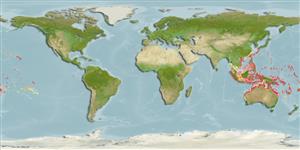>
Eupercaria/misc (Various families in series Eupercaria) >
Lethrinidae (Emperors or scavengers) > Lethrininae
Etymology: Lethrinus: Greek, lethrinia, a fish pertaining to genus Pagellus.
Eponymy: William Sackston Atkinson (1864–c. [...] (Ref. 128868), visit book page.
More on author: Seale.
Environment: milieu / climate zone / depth range / distribution range
Écologie
marin récifal; non migrateur; profondeur 2 - 30 m (Ref. 2295), usually 2 - 18 m (Ref. 37816). Tropical; 31°N - 32°S, 96°E - 134°W
Pacific Ocean: Indonesia and Philippines, north to southern Japan, south to Australia, east to the Tuamoto Islands. Has most frequently been named Lethrinus mahsena.
Length at first maturity / Taille / Poids / Âge
Maturity: Lm ?, range 28 - ? cm
Max length : 50.0 cm TL mâle / non sexé; (Ref. 48635); common length : 32.5 cm TL mâle / non sexé; (Ref. 2295); âge max. reporté: 24 années (Ref. 2290)
Épines dorsales (Total) : 10; Rayons mous dorsaux (Total) : 9; Épines anales: 3; Rayons mous anaux: 8.
Inhabits seagrass beds and sandy areas of lagoons and outer reef slopes. Found singly or in schools. Feeds mainly on crustaceans, mollusks, and fish. Marketed fresh (Ref. 9775).
Life cycle and mating behavior
Maturité | Reproduction | Frai | Œufs | Fécondité | Larves
Gonochorism is inferred for this species as sizes of males and females overlapped and male gonad morphology is typical of secondarily derived testes (Ref. 103751). Juvenile hermaphroditism is exhibited by this species (Ref. 35994).
Carpenter, K.E. and G.R. Allen, 1989. FAO Species Catalogue. Vol. 9. Emperor fishes and large-eye breams of the world (family Lethrinidae). An annotated and illustrated catalogue of lethrinid species known to date. FAO Fish. Synop. 125(9):118 p. Rome: FAO. (Ref. 2295)
Statut dans la liste rouge de l'IUCN (Ref. 130435: Version 2024-1)
Menace pour l'homme
Harmless
Utilisations par l'homme
Pêcheries: intérêt commercial mineur; pêche sportive: oui
Outils
Articles particuliers
Télécharger en XML
Sources Internet
Estimates based on models
Preferred temperature (Ref.
123201): 25.1 - 29.3, mean 28.6 °C (based on 2744 cells).
Phylogenetic diversity index (Ref.
82804): PD
50 = 0.5000 [Uniqueness, from 0.5 = low to 2.0 = high].
Bayesian length-weight: a=0.01585 (0.01032 - 0.02433), b=3.00 (2.88 - 3.12), in cm total length, based on LWR estimates for this species & Genus-body shape (Ref.
93245).
Niveau trophique (Ref.
69278): 3.8 ±0.0 se; based on diet studies.
Résilience (Ref.
120179): Milieu, temps minimum de doublement de population : 1,4 à 4,4 années (K=0.29-0.31; tm=3.7-5; tmax=24).
Prior r = 0.49, 95% CL = 0.33 - 0.74, Based on 1 data-limited stock assessment.
Fishing Vulnerability (Ref.
59153): Moderate vulnerability (35 of 100).
Nutrients (Ref.
124155): Calcium = 44.1 [31.1, 63.0] mg/100g; Iron = 0.829 [0.557, 1.158] mg/100g; Protein = 20.3 [17.7, 22.5] %; Omega3 = 0.123 [0.088, 0.169] g/100g; Selenium = 37.1 [20.8, 58.2] μg/100g; VitaminA = 30.9 [6.9, 161.8] μg/100g; Zinc = 2.07 [1.59, 2.64] mg/100g (wet weight);
